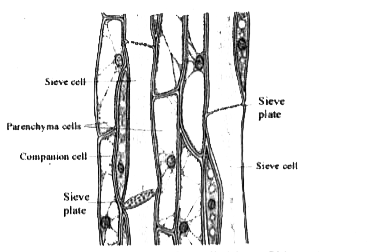with a neat labelled diagram, explain phloem tissue. Solution in Kannada

Phloem is a food conducting tissue and is also called bast. Phloem is composed of four elements.
(a) sieve elements (b) Companion cells © Phloem parenchyma (d) Phloem fibres.
(a) Sieve elements : Sieve elements in lower vascular plants (Pteridophytes and gymnosperms) are referred to as 'sieve cells' whereas in higher plants (Angiosperms) they are referred to as 'sieve tubes'.
Sieve cells are elongated, thin walled, and arranged one above the other , and show thin protoplasmic layer within. Sieve cells posses perforated lateral walls and they are not associated with companion cells, but with the cells albuminous cells.
sieve tubes are much longer than sieve cells and are arranged one above the other longitudinally with perforated transverse end walls, called 'sieve plates' . Protoplasmic strands maintain the continuity through these perforations with the adjoining sieve tubes, sieve tubes are living cells but they are enucleate.
At the end of the growing season , sieve pores are covered by deposits of callose.
(b) Companion cells : These are thin walled living and narrow cells running parallel to sieve tubes in angiosperms. Sieve tubes and companion cells running parallel to sieve tubes in angiosperms. Sieve tubes and companion cells are sister cells derived from the same mother cell. These are known to regulate the functions of sieve tubes, sieve tubes are living cells but they are enucleate.
At the end of the growing season , pores are covered by deposits of callose.
(b) Companion cells : These are thin walled living and narrow cells running parallel to sieve tubes .
(c) Phloem parenchyma : Parenchyma cells associated with phloem are referred to as phloem parenchyma . They are storage in function . Phloem parenchyma is absent in monocot stem.
(d) Phloem fibres : These are sclerenchyma fibres associated with phloem. They are also called bast fibres. They provide mechanical support to the plant body.
Topper's Solved these Questions
- ANATOMY OF FLOWERING PLANTS Book:SUBHASH PUBLICATIONChapter:ANATOMY OF FLOWERING PLANTS Exercise:Two Mark Questions
Explore 14 Videos
- 1 THE LIVING WORLDBook:SUBHASH PUBLICATIONChapter: 1 THE LIVING WORLDExercise:Five mark questions and answers
Explore 5 Videos
- ANIMAL KINGDOMBook:SUBHASH PUBLICATIONChapter:ANIMAL KINGDOMExercise:FIVE MARK QUESTIONS AND ANSWERS
Explore 19 Videos
Similar Questions
Write any four functions of parenchyma tissue
View SolutionWrite a short note on Binomial Nomenelature and guidelines for Binomial Nomenclature.
View SolutionList the salient features of Phylum Annelida.
View SolutionWith a neat labelled diagram, explain how a rainbow is formed.
View SolutionExplain hydraulic separation method with neat and labelled diagram
View SolutionWith a neat labelled diagram, explain the working of a refracting telescope.
View SolutionWith a neat labelled diagram explain Rainbow Formation.
View SolutionExplain the structure of nervous tissue with neat labeled diagram.
View SolutionExplain myopia or short sighteness with a neat labelled diagram
View SolutionExplain with a neat labelled diagram the process of meiosis.
View SolutionExplain the structure of mitochondria with a neat labelled diagram.
View SolutionWith a neat labelled diagram, explain phloem tissue.
View SolutionExplain the components of a biogas plant with a neat labeled diagram.
View SolutionSketch and Label OR Draw neat labelled diagrams. Meristematic tissue.
View SolutionSketch and Label OR Draw neat labelled diagrams. Parenchyma tissue.
View Solution
